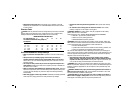
3
• Replacement of the supply cord. If the supply cord is damaged, it must be
replaced by the manufacturer or an authorised DEWALT Service Centre in order
to avoid a hazard.
Extension Cords
CAUTION: Use only extension cords that are approved by the country’s Electrical
Authority. Before using extension cords, inspect them for loose or exposed wires,
damaged insulation and defective fittings. Replace the cord if necessary.
MINIMUM GAUGE FOR CORD SETS
For Cable length (m): 7.5 15 25 30 45 60
Use Cable with minimum rating (Amperes)
Tool Amperes
0 - 3.4 7.5 7.5 7.5 7.5 7.5 7.5
3.5 - 5.0 7.5 7.5 7.5 7.5 10 15
5.1 - 7.0 10 10 10 10 15 15
7.1 - 12.0 15 15 15 15 20 20
12.1 - 20.0 20 20 20 20 25 –
Drill/Driver/Hammerdrill Safety Warnings
• Wear ear protectors with impact drills. Exposure to noise can cause hearing
loss.
• Hold power tools by insulated gripping surfaces when performing an
operation where the cutting tool may contact hidden wiring or its own cord.
Contact with a “live” wire will make exposed metal parts of the tool “live” and
shock the operator.
• Use clamps or other practical way to secure and support the workpiece to a
stable platform. Holding the work by hand or against your body is unstable and
may lead to loss of control.
• Wear ear protectors when hammering for extended periods of time. Prolonged
exposure to high intensity noise can cause hearing loss. Temporary hearing loss
or serious ear drum damage may result from high sound levels generated by
hammerdrilling.
• Wear safety goggles or other eye protection. Hammering and drilling operations
cause chips to fly. Flying particles can cause permanent eye damage.
• Hammer bits and tools get hot during operation. Wear gloves when touching
them.
• Air vents often cover moving parts and should be avoided. Loose clothes,
jewellery or long hair can be caught in moving parts.
WARNING: ALWAYS use safety glasses. Everyday eyeglasses are NOT safety
glasses. Also use face or dust mask if
cutting operation is dusty. ALWAYS WEAR CERTIFIED SAFETY EQUIPMENT:
• ANSI Z87.1 eye protection (CAN/CSA Z94.3),
• ANSI S12.6 (S3.19) hearing protection,
• NIOSH/OSHA/MSHA respiratory protection.
WARNING: Some dust created by power sanding, sawing, grinding, drilling, and
other construction activities contains chemicals known to cause cancer, birth defects
or other reproductive harm. Some examples of these chemicals are:
• lead from lead-based paints,
• crystalline silica from bricks and cement and other masonry products, and
• arsenic and chromium from chemically-treated lumber (CCA).
Your risk from these exposures varies, depending on how often you do this type of
work. To reduce your exposure to these chemicals: work in a well ventilated area, and
work with approved safety equipment, such as those dust masks that are specially
designed to filter out microscopic particles.
• Avoid prolonged contact with dust from power sanding, sawing, grinding,
drilling, and other construction activities. Wear protective clothing and wash
exposed areas with soap and water. Allowing dust to get into your mouth, eyes,
or lay on the skin may promote absorption of harmful chemicals.
WARNING: Use of this tool can generate and/or disburse dust, which may cause
serious and permanent respiratory or other injury. Always use NIOSH/OSHA approved
respiratory protection appropriate for the dust exposure. Direct particles away from
face and body.
WARNING: ALWAYS wear proper personal hearing protection that conforms to
ANSI S12.6 (S3.19) during use. Under some conditions and duration of use, noise
from this product may contribute to hearing loss.
CAUTION: When not in use, place tool on its side on a stable surface where it
will not cause a tripping or falling hazard. Some tools with large battery packs will
stand upright on the battery pack but may be easily knocked over.


















